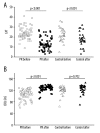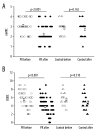Efficiency and safety of pulmonary rehabilitation in acute exacerbation of chronic obstructive pulmonary disease
- PMID: 25783889
- PMCID: PMC4374486
- DOI: 10.12659/MSM.892769
Efficiency and safety of pulmonary rehabilitation in acute exacerbation of chronic obstructive pulmonary disease
Abstract
Background: Pulmonary rehabilitation (PR) is able to improve dyspnea, endurance capacity, and health-related quality of life in chronic obstructive pulmonary disease (COPD) patients, but it is rarely used in China. This study aimed to assess the effectiveness and safety of PR after exacerbation of COPD.
Material and methods: Patients admitted to hospital due to an exacerbation of COPD were randomized to receive either PR or routine care (control group). The PR program was performed from the second day of admission until discharge. The pre-post changes in 6-minute walk distance (6MWD), self-reported quality of life (QOL) assessed by CAT score and CRQ-SAS score, and activity of daily life assessed by ADL-D score were determined. The perceived end-effort dyspnea (Borg scale) was measured throughout the study.
Results: A total of 101 patients were enrolled, of whom 7 withdrew after randomization, and 94 completed this study. There were 66 patients in the PR group and 28 in the control group. The 6MWD, resting SpO2, and exercise Borg dyspnea score were significantly improved in the PR group. In addition, the PR group had greater improvement in the total CRQ-SAS score and had a lower CAT score. Significant improvements were also found in the ADL-D and BODE index in the PR group. No adverse events were recorded during exercise.
Conclusions: Our study provides evidence that it is safe and feasible to apply an early PR in patients with acute exacerbation of COPD.
Figures




Similar articles
-
Power of outcome measurements to detect clinically significant changes in pulmonary rehabilitation of patients with COPD.Chest. 2002 Apr;121(4):1092-8. doi: 10.1378/chest.121.4.1092. Chest. 2002. PMID: 11948037 Clinical Trial.
-
Effect of pulmonary rehabilitation programs including lower limb endurance training on dyspnea in stable COPD: A systematic review and meta-analysis.Respir Investig. 2020 Sep;58(5):355-366. doi: 10.1016/j.resinv.2020.05.010. Epub 2020 Jul 11. Respir Investig. 2020. PMID: 32660900
-
A randomized controlled trial of telephone-mentoring with home-based walking preceding rehabilitation in COPD.Int J Chron Obstruct Pulmon Dis. 2016 Aug 25;11:1991-2000. doi: 10.2147/COPD.S109820. eCollection 2016. Int J Chron Obstruct Pulmon Dis. 2016. PMID: 27601892 Free PMC article. Clinical Trial.
-
Short outpatient pulmonary rehabilitation programme reduces readmission following a hospitalization for an exacerbation of chronic obstructive pulmonary disease.Respirology. 2013 Oct;18(7):1063-8. doi: 10.1111/resp.12141. Respirology. 2013. PMID: 23734624
-
Lower mortality after early supervised pulmonary rehabilitation following COPD-exacerbations: a systematic review and meta-analysis.BMC Pulm Med. 2018 Sep 15;18(1):154. doi: 10.1186/s12890-018-0718-1. BMC Pulm Med. 2018. PMID: 30219047 Free PMC article.
Cited by
-
Results of Physiotherapy Treatments in Exacerbations of Chronic Obstructive Pulmonary Disease: A Systematic Review.Physiother Can. 2017;69(2):122-132. doi: 10.3138/ptc.2015-78. Physiother Can. 2017. PMID: 28539692 Free PMC article.
-
Content, uptake and adherence of exercise interventions after an acute exacerbation of COPD: a scoping review.Eur Respir Rev. 2025 Jan 22;34(175):240172. doi: 10.1183/16000617.0172-2024. Print 2025 Jan. Eur Respir Rev. 2025. PMID: 39843159 Free PMC article.
-
Feasibility of a home-designed respiratory rehabilitation program for chronic obstructive pulmonary disease.Prim Health Care Res Dev. 2024 Jan 30;25:e7. doi: 10.1017/S1463423623000324. Prim Health Care Res Dev. 2024. PMID: 38287510 Free PMC article.
-
Design of pulmonary rehabilitation programmes during acute exacerbations of COPD: a systematic review and network meta-analysis.Eur Respir Rev. 2020 Nov 18;29(158):200039. doi: 10.1183/16000617.0039-2020. Print 2020 Dec 31. Eur Respir Rev. 2020. PMID: 33208486 Free PMC article.
-
Management of severe acute exacerbations of COPD: an updated narrative review.Multidiscip Respir Med. 2018 Oct 2;13:36. doi: 10.1186/s40248-018-0149-0. eCollection 2018. Multidiscip Respir Med. 2018. PMID: 30302247 Free PMC article. Review.
References
-
- Wesseling G, Vrijhoef HJ. Acute exacerbations of COPD: recommendations for integrated care. Expert Rev Respir Med. 2008;2:489–94. - PubMed
-
- Clini EM, Crisafulli E, Costi S, et al. Effects of early inpatient rehabilitation after acute exacerbation of COPD. Respir Med. 2009;103:1526–31. - PubMed
-
- Seemungal TA, Donaldson GC, Bhowmik A, et al. Time course and recovery of exacerbations in patients with chronic obstructive pulmonary disease. Am J Respir Crit Care Med. 2000;161:1608–13. - PubMed
Publication types
MeSH terms
LinkOut - more resources
Full Text Sources
Medical
Research Materials
Miscellaneous

